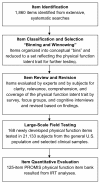Better assessment of physical function: item improvement is neglected but essential
- PMID: 20015354
- PMCID: PMC3003539
- DOI: 10.1186/ar2890
Better assessment of physical function: item improvement is neglected but essential
Abstract
Introduction: Physical function is a key component of patient-reported outcome (PRO) assessment in rheumatology. Modern psychometric methods, such as Item Response Theory (IRT) and Computerized Adaptive Testing, can materially improve measurement precision at the item level. We present the qualitative and quantitative item-evaluation process for developing the Patient Reported Outcomes Measurement Information System (PROMIS) Physical Function item bank.
Methods: The process was stepwise: we searched extensively to identify extant Physical Function items and then classified and selectively reduced the item pool. We evaluated retained items for content, clarity, relevance and comprehension, reading level, and translation ease by experts and patient surveys, focus groups, and cognitive interviews. We then assessed items by using classic test theory and IRT, used confirmatory factor analyses to estimate item parameters, and graded response modeling for parameter estimation. We retained the 20 Legacy (original) Health Assessment Questionnaire Disability Index (HAQ-DI) and the 10 SF-36's PF-10 items for comparison. Subjects were from rheumatoid arthritis, osteoarthritis, and healthy aging cohorts (n = 1,100) and a national Internet sample of 21,133 subjects.
Results: We identified 1,860 items. After qualitative and quantitative evaluation, 124 newly developed PROMIS items composed the PROMIS item bank, which included revised Legacy items with good fit that met IRT model assumptions. Results showed that the clearest and best-understood items were simple, in the present tense, and straightforward. Basic tasks (like dressing) were more relevant and important versus complex ones (like dancing). Revised HAQ-DI and PF-10 items with five response options had higher item-information content than did comparable original Legacy items with fewer response options. IRT analyses showed that the Physical Function domain satisfied general criteria for unidimensionality with one-, two-, three-, and four-factor models having comparable model fits. Correlations between factors in the test data sets were > 0.90.
Conclusions: Item improvement must underlie attempts to improve outcome assessment. The clear, personally important and relevant, ability-framed items in the PROMIS Physical Function item bank perform well in PRO assessment. They will benefit from further study and application in a wider variety of rheumatic diseases in diverse clinical groups, including those at the extremes of physical functioning, and in different administration modes.
Figures


References
-
- Fries JF, Spitz PW, Young DY. The dimensions of health outcomes: the health assessment questionnaire, disability and pain scales. J Rheumatol. 1982;9:789–793. - PubMed
-
- Bruce B, Fries J. The Stanford health assessment questionnaire (HAQ): a review of its history, issues, progress, and documentation. J Rheumatol. 2003;30:167–178. - PubMed
-
- Hambleton R, Swaminathan H, Rogers J. Fundamentals of Item Response Theory. Newbury Park, CA; Sage; 1991.
Publication types
MeSH terms
Grants and funding
LinkOut - more resources
Full Text Sources
Medical
Miscellaneous

